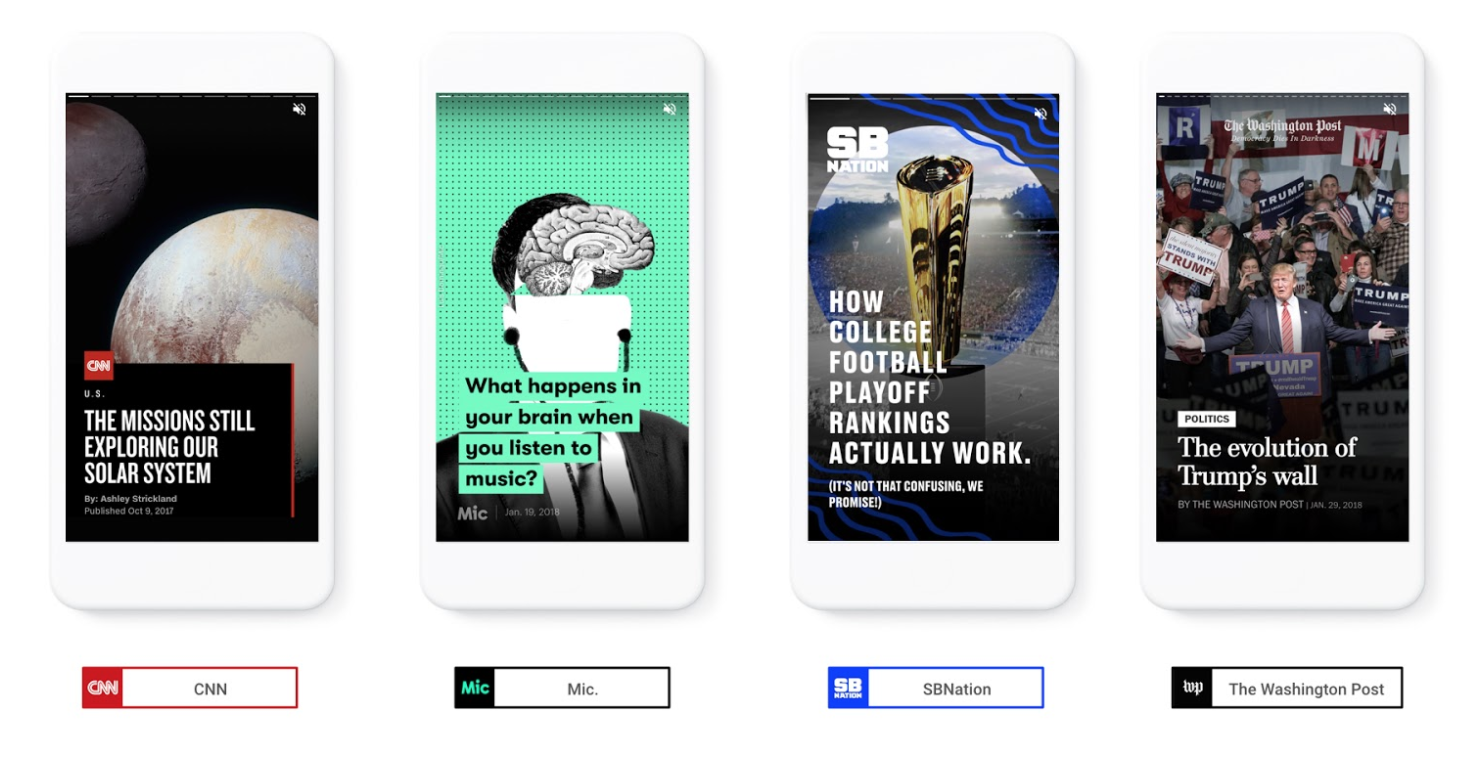Google’s new ‘AMP Stories’: don’t judge new format by its cover

Image: developers.googleblog.com
When Google announced last week that it’s been working with selected publishers to roll out a new product called ‘AMP Stories’, many publishers thought they knew exactly what Google had up its sleeve. The idea has been bantered about before: “A mobile-focused format for delivering news and information as visually rich, tap-through stories.”
Yes, we heard and seen this before, some said. And who could blame them? The ‘stories’ format started with Snapchat, then Instagram quite blatantly copied the idea, and Facebook followed with more of the same, with even less finesse. Even Whatsapp has a comparable format. Why would Google not follow down the same, well-worn path?
Don’t judge too early, warns Pedro Gutiérrez Marticorena, digital development director at Motorpress Ibérica in Spain. Even if AMP stories appear to look the same, these are in fact far removed from the Snapchat, Instagram, Facebook or the Whatsapp formats. He explains that because AMP Stories are built on Google’s AMP (short for ‘Accelerated Mobile Pages’) specifications, it makes AMP Stories open source and available to all developers and publishers, enabling brands to integrate this on their own web page backends. “Beyond this, they can also be displayed on desktop and multiple devices. Most importantly, they can run AMPHtml Ads with new formats built specifically for AMP Stories.”
Despite the fact that Google has said AMP Stories do not support advertising at this stage, Marticorena says its existing AMPHtml Ads has its own formats specifically for AMP Stories and ad networks should embrace them. “Advertisers will love this for sure. Not to mention the possibilities it can deliver in branded content.”
As far as content discovery is concerned, Marticorena says people will reach AMP Stories in exactly the same way they are discovering AMP content at the moment. “The search engine will index them and third party apps will show them.” If integrated with CMS platforms it may allow publishers to showcase them and Google will make them more ‘discoverable” with first positions on search.

Image: developers.googleblog.com
Visual magazine articles
Grzegorz Piechota, Google Digital News senior visiting research fellow at the Reuters Institute for the Study of Journalism, University of Oxford, and research associate with the Harvard Business School agrees. He says the rather misleading name ‘AMP Stories’ could lead to confusion. “AMP Stories are not Google’s equivalents of ‘stories’ on Snapchat, Instagram or Facebook. While stories on social networks enables users to update friends about their life throughout a day with annotated pictures or videos, AMP Stories is a mobile web page format offered to professional publishers.”
Moreover, AMP Stories allow more visual storytelling than basic AMP web pages that consist of just text and illustrations. “AMP Stories look more like visual magazine articles within Snapchat Discover, and this is perhaps the most obvious benchmark.”
He says this holds many advantages for publishers because many may find it easy to upgrade to AMP Stories, as they have already adopted AMP as a standard for their mobile web pages. “Google claims that 31 million websites are using AMP right now.
There is also an incentive in traffic referred by Google. According to Chartbeat, an analytics company, traffic from Google search is currently the biggest part of publishers’ external referral traffic, and most of the page views are coming in mobile and AMP. In fact, traffic referred by Google has been increasing in recent months and many publishers found it more reliable than traffic referred by Facebook, which has been falling,” says Piechota.
An important feature he highlights is the fact that publishers can use the AMP format for their mobile web pages and then link to AMP Stories themselves – on their own sites, in notifications, newsletters and links shared on social. This will be highly effective in increasing discovery. “Google presents AMP Stories along other AMP web pages in a carousel at the top of search results and in Google News.”
Despite all these positives, he agrees that it is still unclear how monetisation options will function because AMP Stories are in a trial phase. “According to Google’s public statements, there is currently no programmatically sold ad breaks in Stories, although one can imagine an ad product similar to what we know from Snapchat Discover. Publishers can also experiment with branded content, for which the new visual format might be very suitable.”
Hear from Greg Piechota at DIS2018, 18-20 March in Berlin. He’ll take part in a panel to discuss the pivot to reader revenues. The Digital Innovators’ Summit is the essential event for quality media businesses to share innovation and insight. Sign up before 13 March to avoid late booking charges.
 |
A publishers specific app
“AMP Stories seems to be about making media richer, closer to the content within publisher specific news apps”, says Steve El-Sharawy, head of innovation at EzyInsights, a content discovery and news tracking aid in Finland. It opens up many new possibilities, especially for smaller publishers. Where well resourced bigger publishers with popular apps have been in a better position to take advantage of creating richer content for their apps, the appearance of AMP Stories may level the playing field. “For smaller publishers the economics of developing their own apps just doesn’t work because they are spending more time creating richer content to reach less of an audience. Not to mention, each publisher’s app will require getting familiar with to create rich media. The advantage with something like AMP Stories is that it has more of a chance to become a standard that works across publishers, so expertise gained at one publisher isn’t wasted when a journalist moves to another.”
El-Sharawy warns that with so much attention given to Facebook’s role in driving content discovery, people should not ignore the fact that Google is also a massive driver of traffic to news sites. “So, although we don’t know how exactly discovery will happen and how far stories will be pushed or get an advantage over other formats, we can assume that given a popular news item, a story might rank higher in terms of prominence. This is good for readers, especially on mobile. We will see what happens if publishers are able to make ‘first strike’ gains by picking the biggest story of the day to cover in this format and the level of prominence/extra traffic they might be able to achieve.”
He says while monetisation remains a permanent concern for publishers, creating ‘stories’ can require more resources than navigating a standard CMS to push out a regular article. “However, stories are less demanding resource wise than putting together high quality video content, or a podcast, not to mention quicker. Reluctance can come through publishers feeling like they are once again having their strings pulled by the puppet master tech companies,” he warns but “Google has an advantage over Facebook in terms of reputation right now.”
 |
Image: developers.googleblog.com
That said, the question is how long it will actually stay this way.
More like this
Google AMP is good for mobile web users – but what about publishers?
The evolution of Google AMP. What happens next?
Google’s Accelerated Mobile Pages Project shows strong results for publishers








